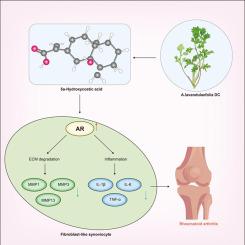Phytomedicine ( IF 6.7 ) Pub Date : 2023-05-31 , DOI: 10.1016/j.phymed.2023.154905 Ruofei Huang 1 , Ruya Li 2 , Jun Chen 3 , Meiyan Lv 4 , Xiangwei Xu 3

|
Objective
The traditional She medicine is a notable type of traditional Chinese medicine, which has been applied for a long history despite the lack of sufficient mechanistic understanding. Our study revealed the possible molecular mechanism of sesquiterpene 5α-Hydroxycostic acid, active ingredient of traditional She medicine Artemisia lavandulaefolia DC., in the treatment of rheumatoid arthritis (RA).
Methods
RA-fibroblast like synoviocytes (RA-FLSs) were treated with 5α-Hydroxycostic acid, Anthemidin, and methotrexate (MTX). CCK-8 and ELISA were used to measure the resultant viability of RA-FLSs and to quantify pro-inflammatory cytokines. Target genes of 5α-Hydroxycostic acid and Anthemidin, RA-related differentially expressed genes, and RA-related genes were retrieved by bioinformatics analyses, results of which were further intersected to identify candidate genes. The protein-protein interaction network was constructed to develop the pharmacophore model. The molecular docking was simulated to determine the core target androgen receptor (AR) for subsequent molecular mechanism investigation in vitro.
Results
The 5ɑ-Hydroxycostic acid, Anthemidin, or MTX of different concentrations inhibited the viability of RA-FLSs, and downregulated the levels of proinflammatory cytokines. The pharmacophore model and molecular docking of 10 candidate targets with 5α-Hydroxycostic acid were successfully established. In vitro experiments provided evidence confirming that 5α-Hydroxycostic acid elevated AR expression to inhibit inflammatory responses of RA-FLSs and degradation of extracellular matrix.
Conclusion
Therefore, this study reveals the active ingredient sesquiterpene 5α-Hydroxycostic acid of traditional She medicine Artemisia lavandulaefolia DC., and illustrates potential molecular mechanism in RA treatment by upregulating AR expression. This study is the first to report the effect of the active ingredient sesquiterpenes in traditional She medicine A.lavandulaefolia DC on RA and elucidate the underlying molecular mechanism associated with up-regulated AR expression. This study provides new insights into the mechanistic understanding of traditional She medicine in the treatment of RA.
中文翻译:

薰衣草药理机制的网络药理学分析。在类风湿性关节炎中
客观的
传统畲医是一种著名的中药类型,尽管对其机理缺乏足够的认识,但其应用历史悠久。我们的研究揭示了传统畲药薰衣草活性成分倍半萜5α-羟基肋酸治疗类风湿性关节炎(RA)的可能分子机制。
方法
用 5α-Hydroxycostic Acid、Anthemidin 和甲氨蝶呤 (MTX) 处理RA 成纤维细胞样滑膜细胞(RA-FLS )。CCK-8 和 ELISA 用于测量 RA-FLS 的活力并量化促炎细胞因子。通过生物信息学分析检索5α-羟基木香酸和Anthemidin的靶基因、RA相关差异表达基因和RA相关基因,并进一步将结果相交以确定候选基因。构建蛋白质-蛋白质相互作用网络来开发药效团模型。模拟分子对接,确定核心靶标雄激素受体(AR),进行后续体外分子机制研究。
结果
不同浓度的5ɑ-Hydroxycostic Acid、Anthemidin或MTX抑制RA-FLS的活力,并下调促炎细胞因子的水平。成功建立了10个候选靶点与5α-羟基肋骨酸的药效团模型及分子对接。体外实验提供的证据证实 5α-Hydroxycostic Acid 升高 AR 表达,从而抑制 RA-FLS 的炎症反应和细胞外基质的降解。
结论
因此,本研究揭示了传统畲药薰衣草的活性成分倍半萜5α-羟基肋香酸,并阐明了通过上调AR表达来治疗RA的潜在分子机制。本研究首次报道了传统畲药薰衣草DC中活性成分倍半萜对RA的作用,并阐明了与上调AR表达相关的潜在分子机制。这项研究为传统畲医治疗 RA 的机制提供了新的见解。











































 京公网安备 11010802027423号
京公网安备 11010802027423号